Menus
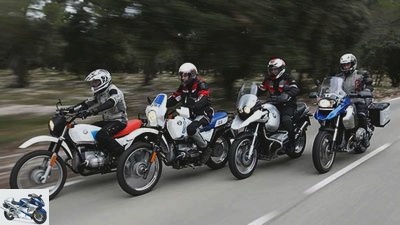
Jahn

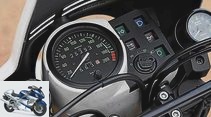
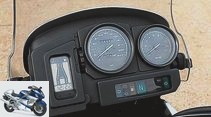

24 photos
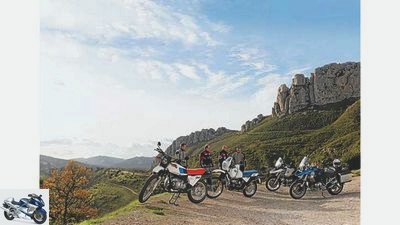
Jahn
1/24
A comparison of four generations of the BMW GS family is intended to examine the progress made over the decades.
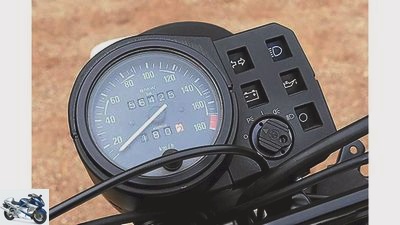
Jahn
2/24
R 80 G / S – trembling hands and not entirely waterproof cases were part of everyday life back then.
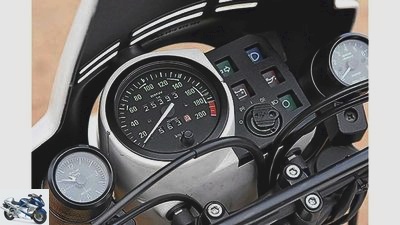
Jahn
3/24
R 100 GS – As with the R 80, there was a tachometer only for an extra charge (190 marks).
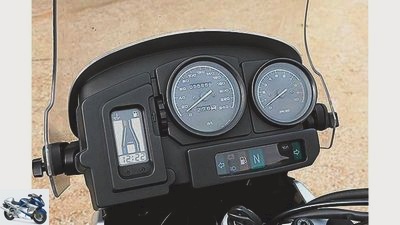
Jahn
4/24
R 1150 GS – still a bit chunky, but at least easy to read and with fuel gauge and gear indicator.
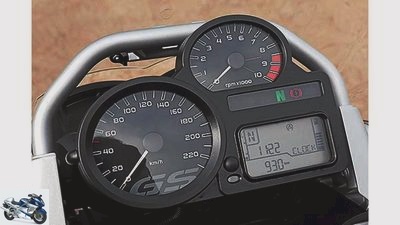
Jahn
5/24
R 1200 GS – unconventionally shaped watches, but the driver can call up countless information on the display.
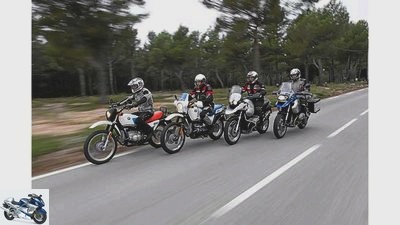
Jahn
6/24
BMW R 80 G / S, R 100 GS, R 1150 GS and R 1200 GS.
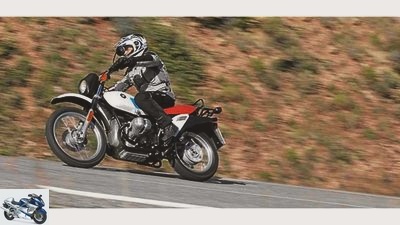
Jahn
7/24
BMW R 80 G / S.

Jahn
8/24
R 80 G / S – two-valve boxer with lower camshaft, push rods and rocker arm.
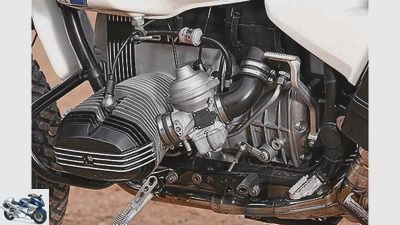
Jahn
9/24
R 100 GS – same stroke as the R 80, more bore – means more displacement and more power.
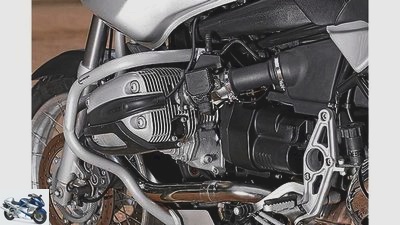
Jahn
10/24
R 1150 GS – One overhead camshaft per cylinder, push rods, four valves, injection.
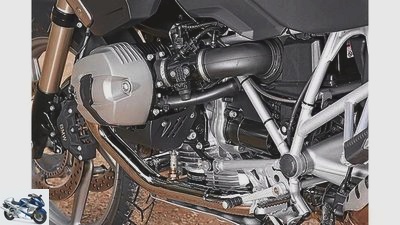
Jahn
11/24
R 1200 GS – two camshafts each, four large, radially arranged valves, rocker arms.
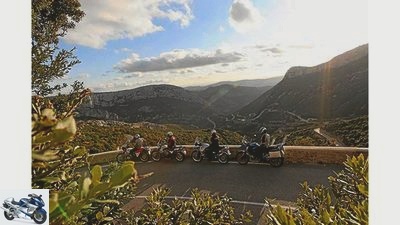
Jahn
12/24
The four GS generations lined up against a fantastic background.
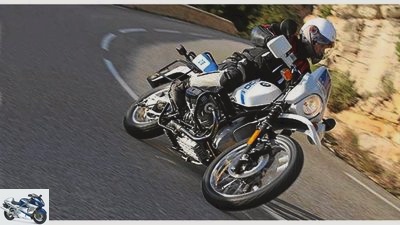
Jahn
13/24
BMW R 100 GS.
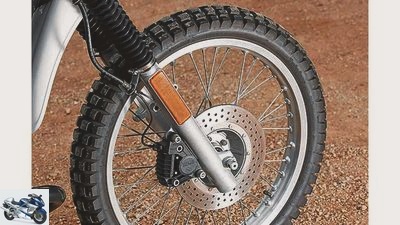
Jahn
14/24
R 80 G / S – two-piston fixed calliper brake: The effect of the single-disc system is extremely poor.
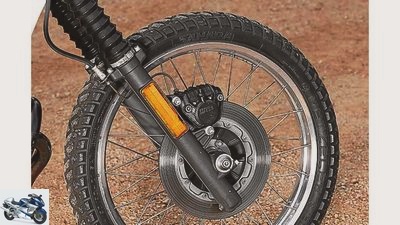
Jahn
15/24
R 100 GS – the lens grew from 260 to 285 mm – the effect remains moderate, especially when it is wet.
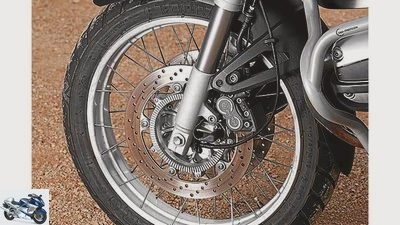
Jahn
16/24
R 1150 GS – four-piston calipers, 305 mm discs, optional ABS (switchable) – it works.

Jahn
17/24
R 1200 GS – that’s the way it should be: crisp bite, significantly more finely regulating ABS (extra charge), top deceleration.
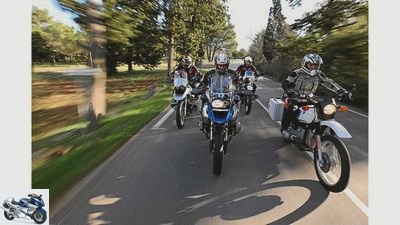
Jahn
18/24
BMW R 1150 GS, R 1200 GS, R 100 GS and R 80 G / S.
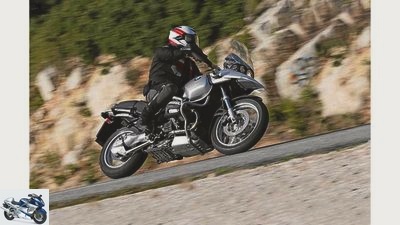
Jahn
19/24
BMW R 1150 GS.
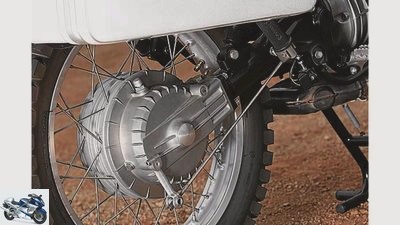
Jahn
20/24
R 80 G / S – novelty: Monolever single-sided swing arm made of cast aluminum tube, integrated cardan.
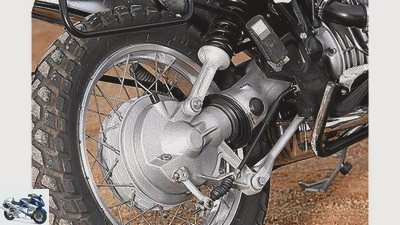
Jahn
21/24
R 100 GS – First double-joint swing arm (Paralever) that eliminates disruptive drive reactions.
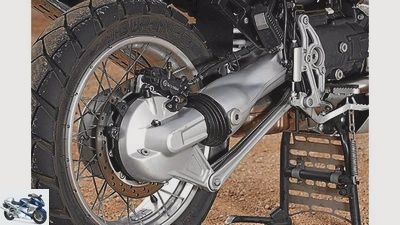
Jahn
22/24
R 1150 GS – Improved Paralever variant with directly hinged central spring strut.
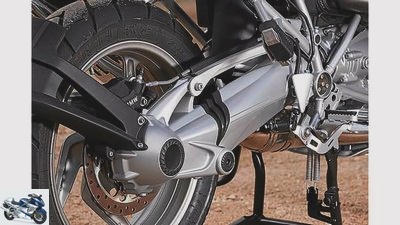
Jahn
23/24
R 1200 GS – Completely new cardan drive, lighter, with overhead torque support.
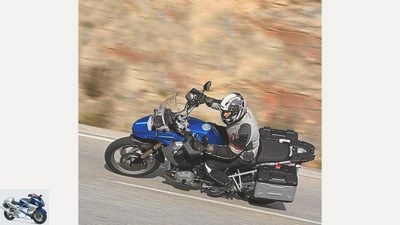
Jahn
24/24
BMW R 1200 GS.
Generation comparison: BMW GS models
The BMW R 1200 GS and its ancestors
For over 30 years, the members of the GS family have been working on the cult status of the boxer-equipped travel bike from Bavaria. A comparison of four generations is intended to examine progress over the decades.
Family reunions are a tricky thing. Some love their relatives, others can’t stand them. At the gathering of the GS family, the common goal, which is always being pursued, to embody the perfect travel enduro, seems to guarantee harmony from the outset. A GS stands and has always stood for the all-rounder: adventure and everyday life. And it was precisely as such that it saw the light of day, the G-slash-S, a bike that should be equally suitable for terrain and road.
D.he wanted to build the largest series enduro to date, and to do this they used various parts from the BMW shelf for cost reasons. The 800 boxer is based on the engine of the road version R 80/7, but the Bavarians gave it some important innovations. The aluminum cylinders received a new Galnical coating, which saves weight, improves thermal behavior, offers higher wear resistance and reduces oil consumption. In addition, a contactless ignition. The frame also comes from the shelf and only had to be adjusted using a mount for the upper suspension strut eye: A mono suspension strut supports the revolutionary single-sided swing arm on the frame. The filigree one-arm construction not only weighs two kilograms less than the conventional swing arm, but can also be 30 percent more rigid. It also makes it easier to remove the wheel – loosen three screws, done. One of these meanwhile rare treasures is now ready and wants to be brought to life by e-starter (she also has the Kickstarter, which is subject to a surcharge). This requires a well-measured use of choke and gas until the boxer bubbles his typical, well-muffled sound out of the high muffler while shaking it appropriately.
Buy complete article
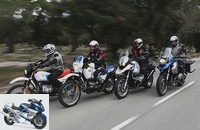
Generation comparison: BMW GS models
The BMW R 1200 GS and its ancestors
Jahn
BMW R 100 GS.
Also no fame: the performance of the Brembo single disc brake. The dull-looking system only lends itself to a noticeable delay when you grasp it firmly. Bite and a firm pressure point are not offered. Fortunately, the astonishingly effective, rod-actuated drum brake at the rear helps. However, those who have zeroed in and maintain a smooth driving style will have a lot of fun with the Ur-GS. Vehicle swapping is the order of the day, jacking up the R 80 G / S requires courageous gripping.
The successor, here in comparison a rare pre-production model of the R 100 GS (still with G / S nameplate), is a bit more capricious than the R 80 when starting from cold.However, it is warmed up thanks to the perfectly synchronized carburetor and the obviously meticulously adjusted valve clearance a perfectly smooth engine run and absolutely clean throttle response. The longer final ratio of the five-speed gearbox takes the boxer, which is also fed up from the very bottom and is blessed with significantly more torque, from the expected plus in liveliness. The reinforced tubular steel frame and the larger brake disc at the front take the higher weight into account – there is little to complain about in terms of stability, but there is certainly in terms of braking performance. As before, the appealing, not particularly effective disc at the front urgently needs the support of the (now cable operated) drum brake at the rear. A 40 mm fork now provides more stability at the front, but the most noticeable innovation is the double-jointed swing arm, called Paralever. The torque support largely prevents the rear from hardening (when accelerating) or collapsing (when releasing the accelerator) the cardan drive is his worst bad habit. In fact, the R 100 GS behaves more calmly when it paces briskly and takes the more precise line. Even if, of course, due to its higher weight, it cannot offer the crisp handling of the R 80. Long-distance travelers will positively note the tank volume, which has grown from 19.5 to 24 liters, with regard to the long range.
While the R 80 G / S shaped the 1980s with its revolutionary concept, the R 100 GS introduced in 1987 the early 1990s, BMW is launching the R 1150 GS at the turn of the millennium. Sure, the 1100s heralded the era of the four-valve engine as early as 1994, with Telelever front wheel guidance and a controversial duckbill front. But here in comparison, the 2000 vintage should show what the status of GS development was at the beginning of the new decade. Because of the evidently changing focus of use of the GS, the focus also changed in the further development of the enduro legend: less off-road capability, more travel comfort. So the weight was allowed to increase to 264 kilograms, rough off-road inserts turn into a risky act of balance and strength. But at least 85 HP are available with the newly developed four-valve boxer. Good when traveling with a pillion passenger and luggage, although the payload of 186 kilograms is very measly. The entry into a new, different GS world is revealed as soon as you get on. The driver is no longer enthroned, but more in the massive machine, in front of him the high, wide handlebars, and even further ahead the steeply standing window that can be adjusted by handwheel.
Jahn
R 100 GS – same stroke as the R 80, more bore – means more displacement and more power.
My GS is my castle. Impregnable. The view into the cockpit falls on the analog, easy-to-read round clocks and the digital display, now even with a gear indicator. Beautiful new world. This is what you think when you start: All you need to do is press the button, the rest is done by the engine management – the boxer shakes itself briefly and goes to work immediately. Long shift travel and bony, hard engaging steps – gear changes are not yet perfect, but on the six-speed box with the long-geared last gear, designed as overdrive, only the first gear, which is too long for tricky passages, can be criticized. The boxer accelerates softly, pushes powerfully from 2000 rpm and only annoys at high speeds with vibrations. The manually adjustable windshield, which stands far ahead and steeply, offers useful wind protection, but it produces disturbing turbulence. The wide bench and the very soft spring elements provide good comfort. In front of the clean and precise leading Telelever, which reduces brake nodding and ensures better front wheel control. The new, more massive Paralever construction also works better than the old R 100 GS. Load change reactions have been minimized again, the hindquarters only tend to trample during maximum acceleration. The spring strut preload can be adjusted to the load using a handwheel; the damping is rather soft at the front and rear.
The braking system with optional ABS, which regulates at larger intervals and with more pronounced pulsation, turned out to be worlds better than with the two-valve models. The four-piston calipers bite resolutely into the two 305 mm discs and also allow sporty late-breaking braking. The 1200 shows, however, that it can be even crisper and with more bite. A real two-finger brake, supported by the fast and hard readjusting ABS, which ensures the shortest possible braking distances. With the cast wheels, which are around two kilograms lighter, instead of the spoked wheels, the GS has finally given up on tough off-road use. It is all the better in scene on country roads. Almost 20 kilograms lighter, with 110 hp significantly more powerful and, especially in the lower range, even more torque, the Bavarian finally mutates into the perfect country road burner. With a more relaxed sitting posture and better padded bench, the 1200 is recommended for both lawns and travel.
Jahn
R 1200 GS – that’s the way it should be: crisp bite, significantly more finely regulating ABS (extra charge), top deceleration.
Right from the start, the high-tech boxer speaks up with a snotty, pithy sound, sounds almost chubby and cheekily spurts out of the exhaust when overrun, which now has a control flap to optimize the sound and torque. Double ignition (already had the 1150s from 2003) and balance shaft contribute to the praiseworthy running smoothness of the boxer without annoying vibrations. It is almost pointless to mention that the youngest, most modern GS with its optimized center of gravity drives most neutrally and does not achieve the playful handling of the R 80 G / S, but is astonishing in view of the proud weight of the 1200s. With the fundamentally tighter design of the suspension and the ESA (electronic suspension adjustment) on board, which is subject to a surcharge, the 2011er always provides the right spring and damping characteristics and thus becomes the boss when it comes to suspension. Thanks to the latest injection electronics, the R 1200 GS even shines with the lowest consumption. So there is no question about it, the latest is also the best GS. But the ancestor R 80 G / S also proves to be a tough dog, is by no means old-fashioned and is still up for almost any fun on nimble soles. The GS family lives – in a further developed form. And the descendants in their segment still have the nose, or rather the beak in front. More than ever and hard to miss.
Conclusion
The world is changing. The demands on the GS too, and they have adapted. The 1200 is for sure the best GS of all time and exactly meets today’s demands. The heavy 1150 can do some things almost as well, but the progress is noticeable – not just in the transmission, brakes and chassis. The old two-valve engines shine with charm and show astonishing stamina. But when it comes to starting behavior, braking, driving stability, etc., two- and four-valve engines are worlds apart. Significant: The R 80 G / S in particular is still fun today.
Engine / cockpit
Jahn
R 80 G / S – trembling hands and not entirely waterproof cases were part of everyday life back then.
engine
The GS has always remained true to the boxer, but there are worlds between the two-valve engine from 1980 and today’s engine.
In the public perception, boxer engines belong to BMW motorcycles like the Beetle to VW. The short, compact design, the (theoretically) perfect mass balancing by the opposing pistons that lie in one plane speak for the construction principle of the boxer, which has a long tradition at Bavaria: the first motorcycle, the R32 from 1923, had one Boxer engine and the obligatory cardan drive. The flat construction of the boxer with the two horizontal cylinders, which are air-cooled by the airstream, allows a low center of gravity thanks to the appropriate installation position – good for handling and balancing the bike. It is true that installing two separate cylinder heads is more complex, but the easily accessible arrangement makes maintenance work easier. Two-valve technology was standard for a long time, and it wasn’t until 1993 that four-valve control was introduced.
R 1200 GS
Boxer on the outside, nice on the inside: there are around 30 years between these two engine interiors
R 80 G / S
Two-valve boxer with lower camshaft, push rods and rocker arm
R 100 GS
Same stroke as the R 80, more bore – means more displacement and more power
R 1150 GS
One high-lying camshaft per cylinder, bumpers, four valves, injection
R 1200 GS
Two camshafts each, four large, radially arranged valves, rocker arms
cockpit
The range of information is increasing, and the development towards the digital display does not stop at the GS.
R 80 G / S
Shaking hands and not entirely waterproof cases were part of everyday life back then
R 100 GS
As with the R 80, there was a tachometer only for an extra charge (190 marks)
R 1150 GS
Still a bit chunky, but at least easy to read and with fuel gauge and gear indicator
R 1200 GS
Unconventionally shaped watches, but the driver can call up countless information on the display
Cardan / brake
Jahn
R 1150 GS – Improved Paralever variant with directly hinged central spring strut.
Cardan
The maintenance-free cardan drive and the clever single-sided swing arm have always been loyal allies with the GS.
Others should struggle with wear-and-tear and maintenance-intensive chain drives: At BMW, boxers and cardan shafts were used early on on the drive horse, which is still active today and is considered to be the right one. Too bad that for a long time the typical elevator effect determined the driving behavior of the boxer BMWs: the rearing up (and hardening of the suspension) when accelerating, the sagging (with the risk of touching down in an inclined position) when releasing the accelerator as the principle-related consequences of the cardan drive torque. With the ingenious invention of the monolevers, the stable single-sided swing arm that guides the cardan shaft inside, this effect was not eliminated, but the development was on the right track. The weight could be reduced and the stability increased. The breakthrough came with the R 100 GS: The parallelogram-like torque support between the rear axle drive and the frame prevents the disruptive effect and is convincing in all of the following models.
R 1200 GS
Monolever – born in 1980 as a sensation, today it is impossible to imagine Paralever without it
R 80 G / S
Novelty: Monolever single-sided swing arm made of cast aluminum tube, integrated cardan
R 100 GS
First double-jointed swing arm (Paralever), which eliminates disruptive drive reactions
R 1150 GS
Improved Paralever variant with directly hinged central spring strut
R 1200 GS
Completely new cardan drive, lighter, with overhead torque support
brake
20 or 30 years ago you had to grab hold of a full paw, today two fingers are enough.
R 80 G / S
Two-piston fixed caliper brake: The effect of the single disc system is extremely poor
R 100 GS
The pane grew from 260 to 285 mm – the effect remains moderate, especially when it is wet
R 1150 GS
Four-piston calipers, 305 mm discs, optional ABS (which can be switched off) – it works
R 1200 GS
This is how it should be: crisp bite, much finer ABS regulating (surcharge), top delay
Technical specifications
Jahn
BMW R 80 G / S, R 100 GS, R 1150 GS and R 1200 GS.
| BMW R 80 G / S | BMW R 100 GS | |
| engine | design type | Two-cylinder four-stroke boxer engine | Two-cylinder four-stroke boxer engine |
| injection | Constant pressure carburetor, Ø 32 mm | Constant pressure carburetor, Ø 40 mm | coupling | Single-disc dry clutch | Single-disc dry clutch |
| Bore x stroke | 84.8 x 70.6 mm | 94.0 x 70.6 mm | Displacement | 798 cm3 | 980 cm3 |
| compression | 8.2: 1 | 8.5: 1 | power | 37.0 kW (50 PS) at 6500 rpm | 44.0 kW (60 hp) at 6500 rpm |
| Torque | 57 Nm at 5000 rpm | 76 Nm at 3750 rpm | landing gear |
| frame | Double loop tubular steel frame | Double loop tubular steel frame | fork | Telescopic fork, Ø 36 mm | Telescopic fork, Ø 40 mm |
| Brakes v / h | Ø 260/200 mm | Ø 285/200 mm | Assistance systems | – | – |
| bikes | 1.85 x 21; 2.50 x 18 | 1.85 x 21; 2.50 x 17 | tires | 3.00-21; 4.00-18 | 90 / 90-21; 130 / 80-17 |
| mass and weight | wheelbase | 1465 mm | 1514 mm |
| Steering head angle | 62.5 degrees | 62.0 degrees | Suspension travel v / h | 200/170 mm | 225/180 mm |
| Seat height | 860 mm | 860 mm | Weight with a full tank | 196 kg | 225 kg |
| Payload | 202 kg | 195 kg | Tank capacity | 19.5 liters | 26.0 liters |
| Base price | 8290 DM (1980) | 12990 DM (1987) | MOTORCYCLE readings |
| Top speed | 168 km / h | 181 km / h | Acceleration 0-100 km / h | 6.1 sec | 5.1 sec |
| Pulling speed 60–140 km / h | 13.5 sec | 11.5 sec | Consumption highway | 5.6 liters | 5.0 liters |
| Range | 354 km | 520 km |
| BMW R 1150 GS | BMW R 1200 GS | engine | |
| design type | Two-cylinder four-stroke boxer engine | Two-cylinder four-stroke boxer engine | injection | injection, | Injection, Ø 50 mm |
| coupling | Single-disc dry clutch | Single-disc dry clutch | Bore x stroke | 101.0 x 70.5 mm | 101.0 x 73.0 mm |
| Displacement | 1130 cm3 | 1170 cm3 | compression | 10.3: 1 | 12.0: 1 |
| power | 62.5 kW (85 PS) at 6800 rpm | 81.0 kW (110 hp) at 7750 rpm | Torque | 98 Nm at 5300 rpm | 120 Nm at 6000 rpm |
| landing gear | frame | Load-bearing engine-gearbox connection | Load-bearing motor-gear unit |
| fork | wishbone guided telescopic fork, Ø | Telescopic fork guided by longitudinal control arm, Ø 41 mm | Brakes v / h | Ø 305/276 mm | Ø 305/265 mm |
| Assistance systems | SECTION | SECTION | bikes | 2.50 x 19; 4.00 x 17 | 2.50 x 19; 4.00 x 17 |
| tires | 110/80 R 19; 150/70 R 17 | 110/80 R 19; 150/70 R 17 | mass and weight |
| wheelbase | 1509 mm | 1507 mm | Steering head angle | 64.0 degrees | 64.3 degrees |
| Suspension travel v / h | 190/200 mm | 190/200 mm | Seat height | 850-870 mm | 855-875 mm |
| Weight with a full tank | 264 kg | 246 kg | Payload | 186 kg | 194 kg |
| Tank capacity | 22.0 liters | 20.0 liters | Base price | 19890 DM (2000) | 13150 euros |
| MOTORCYCLE readings | Top speed | 195 km / h | 215 km / h |
| Acceleration 0-100 km / h | 4.3 sec | 3.7 sec | Pulling speed 60–140 km / h | 12.6 sec | 7.8 sec |
| Consumption highway | 4.8 liters | 4.7 liters | Range | 458 km | 426 km |
Related articles
-
Generation comparison: Honda CBR 600 F
Rivas Generation comparison: Honda CBR 600 F The Honda Sportourer compared to its ancestors The new CBR 600 F has a difficult legacy. What does progress…
-
Two enduros in comparison: BMW R 80 G-S and Honda XLV 750 R
Jahn 23 pictures Jahn 1/23 Cruising through the country without hectic: You don’t always have to go rally-like on off-road slopes. Jahn 2/23 Not so …
-
Generation comparison Suzuki 1200-1250 Bandit
Generation comparison Suzuki 1200/1250 Bandit Glorious bandits Suzuki’s extremely successful large Bandit models are the prelude to a new …
-
Generation comparison: Kawasaki’s sports tourers compared over 27 years
Bilski 21 pictures Bilski 1/21 In 1984 the Kawasaki GPZ 900 R was a big hit. It filled a gap between tourers and athletes. 27 years …
-
Generation comparison: lightweight motorcycles
Jahn Generation comparison: lightweight motorcycles Lightweight bikes in comparison Content of A man builds a dream. Rudiger Kranz is a lightweight…
-
Catalog section: All current BMW models
Catalog section: All current BMW models White-blue stories From the cuddly cabin scooter to the assembled boxer clique to the four-cylinder …
-
Comparison test two-cylinder: BMW R 1200 R, Buell Lightning XB12Ss and Moto Guzzi Griso 8V
fact comparison test two-cylinder: BMW R 1200 R, Buell Lightning XB12Ss and Moto Guzzi Griso 8V Big Twins only 1170, 1202, 1151 ?? these…
-
Yamaha XJ 650, XJ 650 Turbo and XJ 900 F in comparison test
Bilski comparison test Yamaha XJ 650 / XJ 650 Turbo / XJ 900 F four-cylinder Yamahas in comparison test Contents of Yamaha’s XJ series are still considered …
-
Comparison test: seven enduro bikes in Sweden
Jahn 28 pictures Jahn 1/28 The operation of the Multistrada has also changed: A control center for electronics and motor directly on the handlebar. Jahn 2/28 …
-
Jahn comparison test Powercruiser Kawasaki VN 2000, Suzuki Intruder M 1800 R, Yamaha XV 1900 Midnight Star Punchtime Nobody distributes more displacement and …